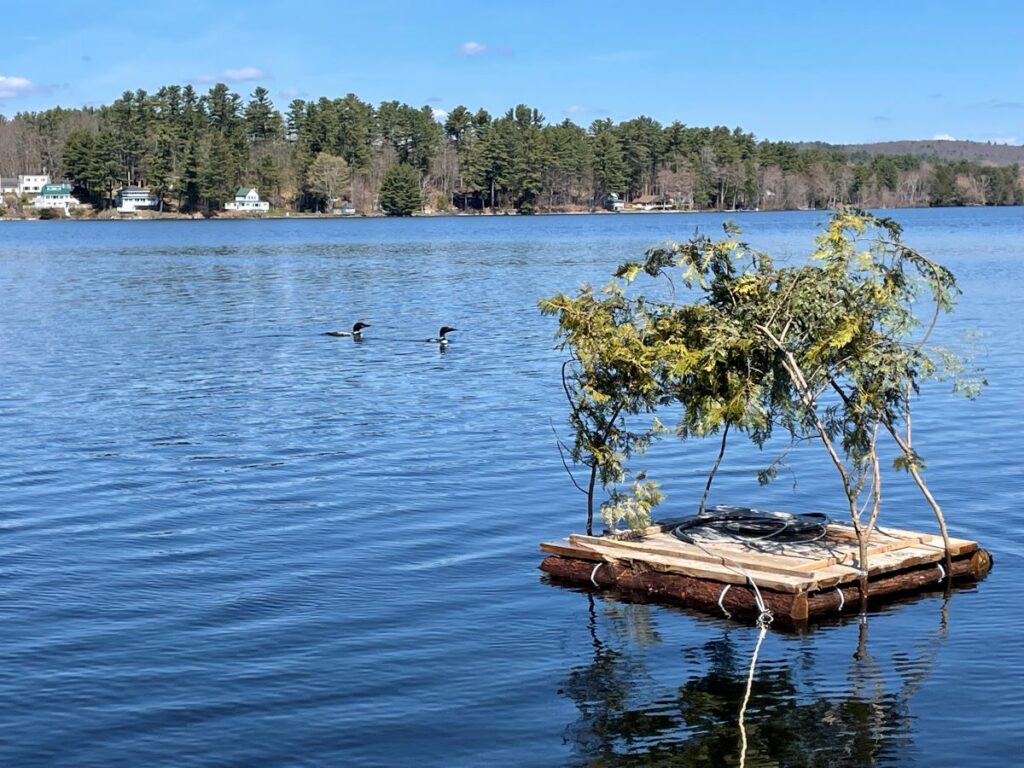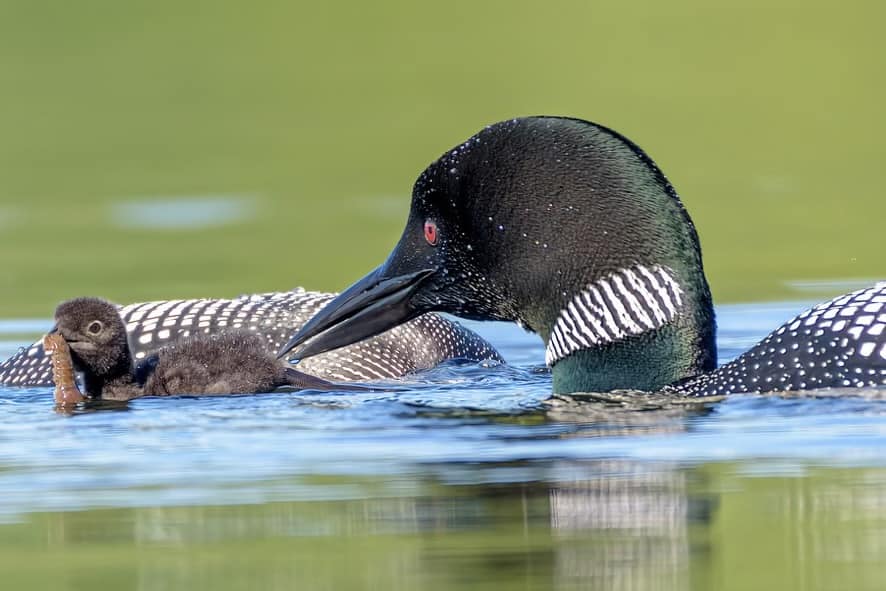
One of Maine Audubon’s most visible projects is the Annual Loon Count, where more than 1500 volunteers go out, on the third Saturday in July, to count loons and give us a snapshot of the loon population. But we’ve also got a major project aimed at increasing loon nesting success and survival, called the Maine Loon Restoration Project. For the last three years, Maine Audubon has worked in partnership with Maine Lakes, Lakes Environmental Association, the Penobscot Nation, and hundreds of volunteers to place nesting platforms, reduce nest disturbance, and curb lead tackle use. As the 2023 season wraps up, wildlife ecologist Tracy Hart gives us a recap of this year’s highs and lows.
By any measure, 2023 was a challenging season, but especially for our efforts to deploy nesting rafts to assist loon pairs that have a history of nest failure. First was the weather. The constant rain storms caused docks and boats to float away, upending our best-laid plans. Waves kicked up by strong winds washed plants off the rafts and record high water had us returning to certain rafts to install longer anchor lines. We couldn’t wait for nice days because there just weren’t enough of them, but hardy local participants paddled out with us no matter the weather. As one volunteer described, “We launched our raft in the rain/hail/even some snow, and every time [staff] came to monitor the raft it rained (even poured). Everyone handled the weather as good sports with lots of laughter.”
In addition to the weather, boats and trucks broke down and some supplies were out of stock, which sent us looking for creative solutions and alternate transportation. These challenges are part of the nature of field work, but hit all new levels this year.
Still, through all that nature threw at us and even where Murphy’s law prevailed, we launched 57 nesting rafts with the help of local participants by mid-May: 27 redeployments from last year and 30 new rafts. A total of 17 downy chicks hatched from these rafts, many from parents that hadn’t hatched a chick in years! And another 10 loon pairs we put out rafts for hatched chicks from nests onshore, despite the high water levels. But young loons live in a dangerous world and, sadly, some of these chicks didn’t make it. We cheered that much louder for the chicks that grew large enough to fly to the coast for the winter.
Getting to these outcomes took the effort of hundreds of volunteers. More than 330 volunteers served as community scientists tracking loon pairs on their lakes and watching over the rafts with the help of Maine Audubon, Lakes Environmental Association, and the Penobscot Nation. Another 44 local residents received training from Maine Lakes as part of the Look Out for Loons program, and went on to conduct local outreach that reached more than 1000 lake users with information on how to protect loons. Others hosted 17 tackle exchange events or put up lead tackle collection bins to help reduce lead poisoning in loons. None let the weather stop them!
At the end of the day, all of us could go home to warm up and dry off. So what did all the weather mean for the loons?
Some pairs just seemed to throw in the towel this season and didn’t even attempt nesting. Within the 57 breeding territories where we deployed rafts, 19 of the pairs didn’t nest—a third! While many that nested on the rafts were successful, things didn’t always go as we hoped. Three pairs overincubated—meaning that we all excitedly watched the pair climb onto the raft, lay eggs, and then sit on the raft . . . and then sit and sit, way past the normal incubation period of just under a month. The eggs never hatched. Did the weather play a part?
We had expected that more pairs might take to the rafts given the rainfall in early spring, since rafts rise and fall with changing water levels. But for unknown reasons proportionally fewer pairs nested on rafts this year (just over 1/4 of the rafts were used this year versus 1/3 last year). Some shoreline nests did flood when lake levels rose, but surprisingly 10 of the 23 pairs that chose not to nest on rafts hatched chicks from onshore nests. A few participants relayed that these pairs managed to fit in egg incubation between the biggest storms.
Interestingly, some of the pairs that hatched chicks from shoreline nests hadn’t been successful in many years, sometimes for decades! So why were they successful this year? I’ll hazard a guess. Many of the project participants commented how quiet it was on the lakes in the spring and early summer and how few people they saw out on the water during nesting season. Perhaps the pairs that hatched chicks on natural nests after dismal past productivity are ones normally impacted by human disturbance or nest flooding from boat wakes. If the theory holds, this year may give us more insight into the pairs that might benefit most from outreach to reduce disturbance and boat speeds, or from warning signs if nests are in high-traffic locations.
The other benefit of the quiet was that fewer distressed loons and loon deaths were reported all the way into August. This may, in part, have been because people weren’t out there to detect injured, sick, or dead loons, but with reduced lake recreation there were also likely fewer boat strikes, less harassment, and less lead tackle being used. Recently, there has been an uptick in reported loons, coincident with the increase in lake use at the end of the season.
As the Maine Loon Restoration Project continues, we are learning more about how to assist loons that struggle to hatch chicks as a result of nest flooding and human intrusion, and how to better address threats to survival. For example, we’ve long known that lead poisoning is a major threat to loons, and this past year we passed legislation to help keep more lead tackle out of our lakes. With the help of hundreds of lake residents, we are also getting the word out to slow down around loon families and nesting areas. Though 2023 threw out some challenges, Maine’s loons have a brighter future thanks to the partners and participants in the Maine Loon Restoration Project. Learn more about the project here >
Above photo: A loon pair watching as we hauled a raft to a deployment site. Photo by Tracy Hart.

